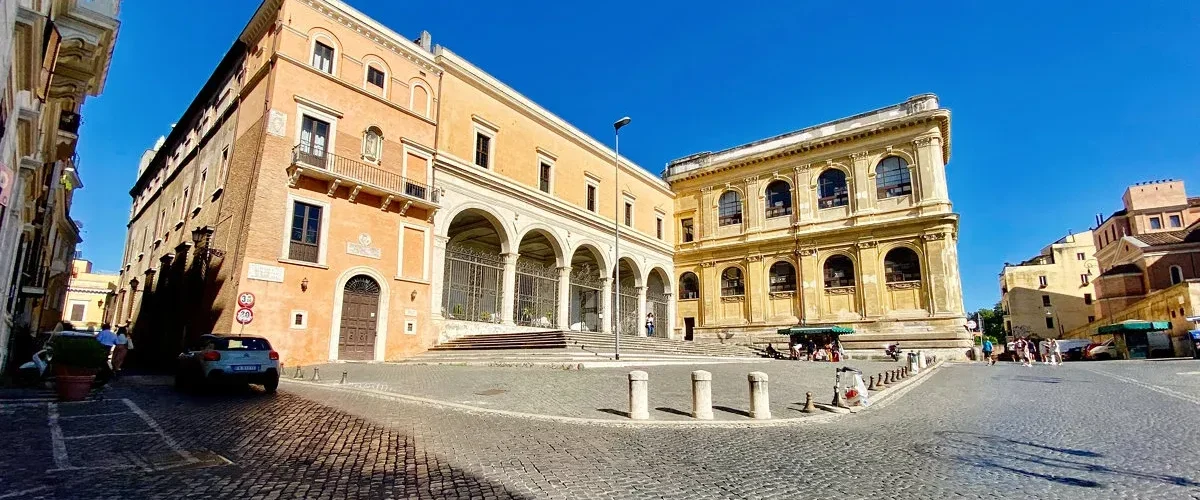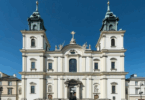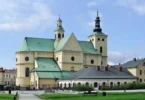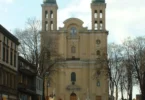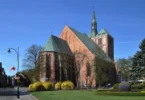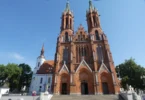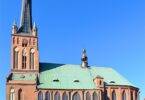Introduction
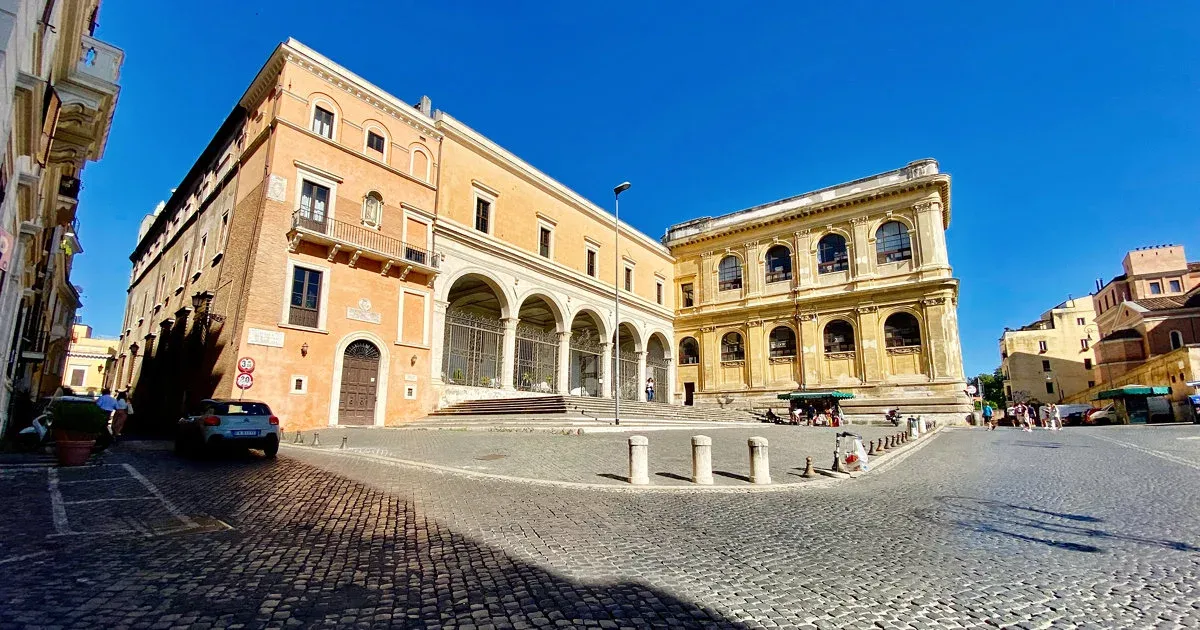
San Pietro in Vincoli (Saint Peter in Chains) is a Roman Catholic titular church and minor basilica located in the historic center of Rome, Italy. Situated on the Oppian Hill in the Monti district, it lies close to Cavour metro station and is just a short walk from the Colosseum. The name of the church references the Biblical story of Saint Peter’s miraculous liberation from prison, as recounted in the Acts of the Apostles. This church is renowned primarily for housing Michelangelo’s iconic statue of Moses, which is part of the monumental tomb of Pope Julius II. The tomb, which was conceived by Julius II himself, stands as one of Michelangelo’s most famous and ambitious works, and the statue of Moses is one of its most remarkable features.
San Pietro in Vincoli was originally established in the 5th century by Licinia Eudoxia, the wife of the Roman Emperor Valentinian III, and is sometimes referred to as the Eudoxian Basilica in her honor. The basilica is historically significant for housing relics of Saint Peter’s chains, which are displayed in a prominent altar area. The church’s association with Saint Peter and his chains symbolizes the story of his miraculous escape from imprisonment, enhancing its sacred importance. The basilica also serves as a rectory, managed by the canons regular of the Congregation of the Most Holy Savior Lateran. The title of Cardinal-Priest of San Pietro in Vincoli has been held by various distinguished figures, including Cardinal Donald Wuerl, who assumed the role in 2010 following the death of Cardinal Pio Laghi.
In addition to its religious significance, the basilica is linked to modern academic life. The building adjacent to the church, once a convent, now houses the Faculty of Engineering at La Sapienza University, which is also known as “San Pietro in Vincoli.” With its rich history, architectural beauty, and artistic treasures, San Pietro in Vincoli continues to be an important site of both worship and cultural heritage in Rome.
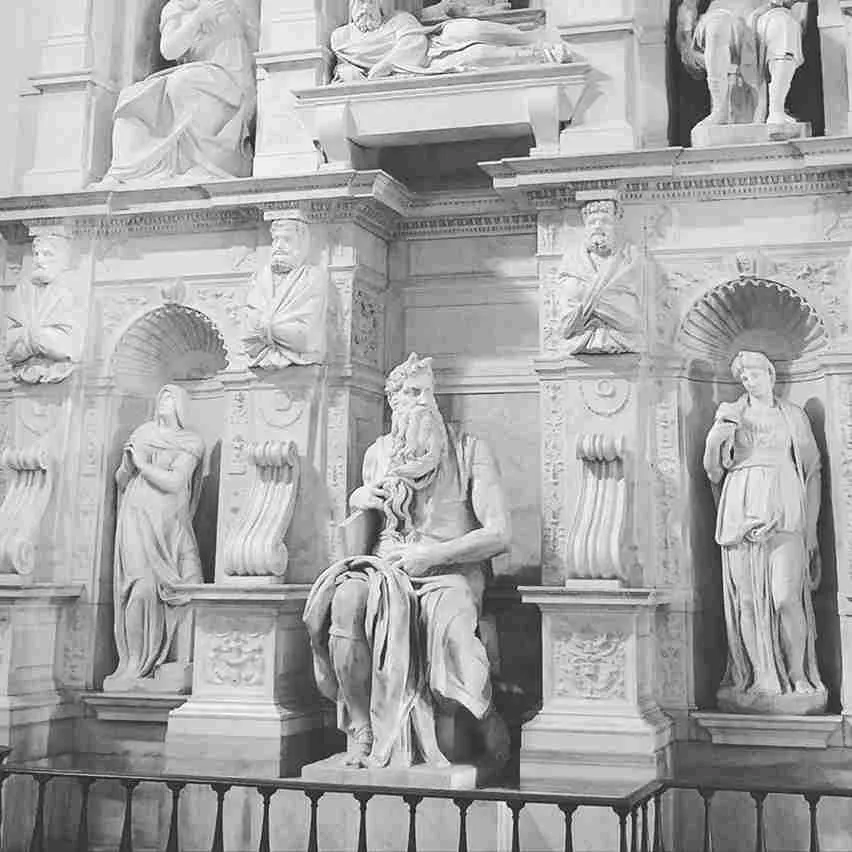
Early Foundations and Construction (432-439)
San Pietro in Vincoli, also known as the Basilica Eudoxiana, was first constructed between 432 and 439 to house the relics of Saint Peter’s chains, which were believed to have bound him during his imprisonment in Jerusalem, as recounted in the biblical “Liberation of Saint Peter.” The relics were gifted to the church by Empress Eudoxia, the wife of Emperor Valentinian III, who had received them from her mother, Aelia Eudocia, during a pilgrimage to Jerusalem in 438-439. The chains were presented to Pope Leo I, and it was said that when the chains from Jerusalem were brought to Rome and placed alongside those that had been held in the Mamertine Prison, they miraculously fused together.
The basilica was consecrated in 439 by Pope Sixtus III, who oversaw the establishment of the church as a significant religious site. It was originally built on the site of an earlier Christian building known as the titulus apostolorum, which was dedicated to the Apostles. Archaeological excavations have revealed that the church was built on the ruins of a complex dating back to the 3rd century BC, part of the Domus Transitoria Neroniana, a grand Roman residence.
Rebuilding and Restorations
Over the centuries, the church underwent numerous reconstructions and restorations. After its original construction, the basilica experienced various phases of rebuilding, including a major restoration by Pope Adrian I in the 8th century. Pope Sixtus IV made significant improvements to the basilica during the late 15th century, while Pope Julius II, in the late 15th and early 16th centuries, oversaw additional work, including the addition of the front portico in 1475 and the creation of a cloister attributed to Giuliano da Sangallo (1493-1503). The cloister, with its central well designed by Simone Mosca in 1517, is a notable feature and has been restored in recent years.
In the 18th century, further renovations took place under the direction of architect Francesco Fontana, including lowering the vault. The basilica was again restored in 1875, solidifying its place as one of Rome’s enduring religious landmarks.
The Significance of the Chains and the Miracle
The chains that are now housed in a reliquary beneath the main altar of the basilica have become an important symbol of the church. According to tradition, the two chains—one from Jerusalem and the other from the Mamertine Prison—fused together in a miraculous event, signifying the unity between the Eastern and Western Roman Empires. This event carried both religious and political significance during a time when the Empire and the Papacy were facing external threats, including invasions from barbarian tribes.
The basilica’s association with Saint Peter’s chains continues to hold great religious meaning, attracting pilgrims and visitors from around the world. The basilica also became a symbol of the enduring bond between the East and the West during a period of political turbulence. The church’s association with both religious devotion and imperial history is further emphasized by its continued restoration and preservation.
The church’s convent building, which was once an integral part of the complex, now houses the Faculty of Engineering at La Sapienza University, adding a modern academic dimension to the historic site. The central well in the cloister and the fountain from 1642, a gift from Cardinal Antonio Barberini, stand as enduring symbols of the basilica’s long and multifaceted history.
Architect: Giuliano da Sangallo
Architectural Styles: Renaissance architecture
Interior of the Basilica of San Pietro in Vincoli
The Basilica of San Pietro in Vincoli has a traditional structure with a central nave and two side aisles, creating a spacious and harmonious interior. The basilica is divided into three apses by a set of Doric columns, which were originally part of an ancient Roman building. These columns give the church its classic, monumental feel. The aisles are covered with cross-vaults, while the central nave is topped with a barrel-vaulted ceiling adorned with coffers. The ceiling, redesigned in the 18th century, features a fresco by Giovanni Battista Parodi, painted in 1706. The fresco portrays the Miracle of the Chains, a fable where Pope Alexander heals the mythical Saint Balbina’s goiter by touching her with the chains that once bound St. Peter. This event is based on legend rather than historical facts.
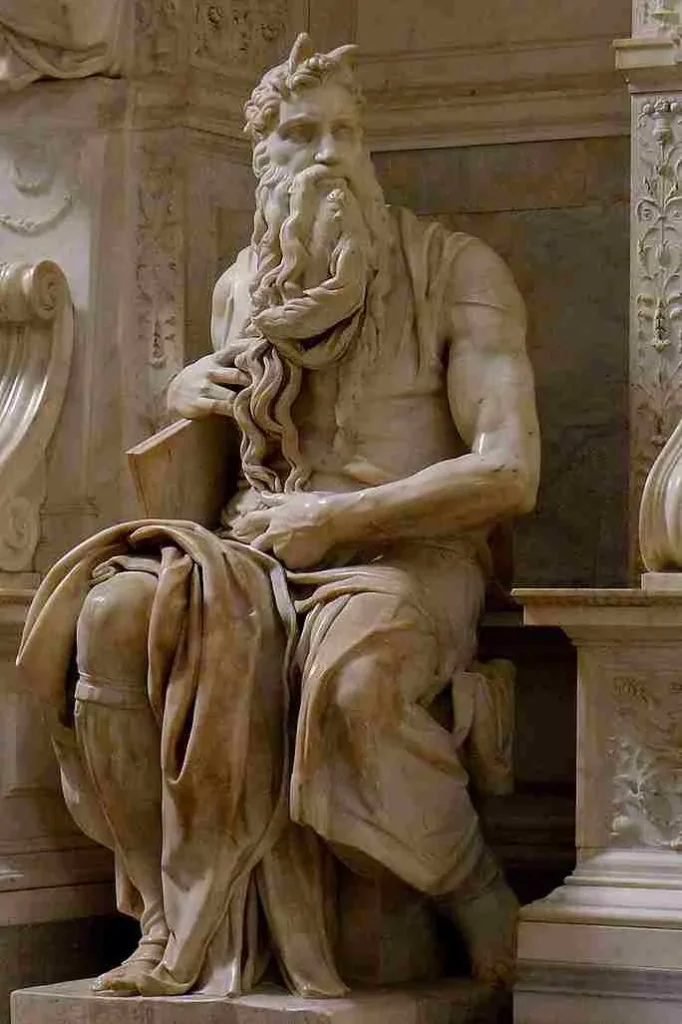
One of the most famous and significant works within the basilica is Michelangelo’s Moses. Completed in 1515, this statue was originally designed as part of a grand funeral monument for Pope Julius II, which was to include 47 statues. However, due to various interruptions, the final monument, completed in 1545, was much smaller, consisting of seven statues, with Moses as the centerpiece. Moses is depicted with horns, an iconographic symbol connoting “the radiance of the Lord.” This feature comes from a mistranslation of the Hebrew term for “beams of light” as “horns.” While early Christian art often depicted sacred figures with such symbolism, sculpting horns was simpler than sculpting rays of light, making it a more practical artistic choice.
Other Works of Art
The basilica houses numerous other significant artworks, including:
- Two paintings of Saint Augustine and Saint Margaret by the Baroque artist Guercino.
- The Monument of Cardinal Girolamo Agucchi, designed by Domenichino, which includes a fresco in the sacristy, painted by Domenichino in 1604, depicting the Liberation of St. Peter.
- Deposition of Christ by Cristoforo Roncalli, displayed on the first chapel’s left side.
- Tomb of Cardinal Nicholas of Cusa, with a relief showing the cardinal venerating Saint Peter, sculpted by Andrea Bregno in 1465.
- Antonio del Pollaiuolo’s Tomb, located near the entrance, featuring a sculpture that includes Romulus and Remus from the Capitoline Wolf.
- A contemporary work, When I Was Naked by Canadian artist Timothy Schmalz, installed during the Extraordinary Jubilee of Mercy.
The Tomb of Cardinal Cinzio Aldobrandini
The Tomb of Cardinal Cinzio Aldobrandini, erected between 1705 and 1707, was designed by architect Carlo Francesco Bizzaccheri. It is adorned with sculptures by Pierre Le Gros the Younger, including putti (cherubic figures) and a winged skeleton. This tomb exemplifies Baroque funerary art, which often features symbolic depictions of death and the afterlife.
The Maccabean Martyrs
In 1876, archaeologists discovered the tombs of individuals believed to be the Seven Maccabean Martyrs mentioned in 2 Maccabees 7:41. Although it is now highly unlikely that these are the remains of the historical Jewish martyrs, they are still commemorated annually on August 1st, the same day as the miracle of the fusion of the chains of Saint Peter.
The Mosaic of Saint Sebastian
Located on the third altar in the left aisle, a 7th-century mosaic depicts Saint Sebastian. This mosaic was originally a votive offering, created during an outbreak of plague in Pavia in 680. As Saint Sebastian was believed to have been born in Lombardy, his relics were brought to Pavia to stop the plague. As a symbol of the enduring relationship between Pavia and Rome, an identical altar to the one in Pavia was built in the basilica.
Basilica Structure and Design
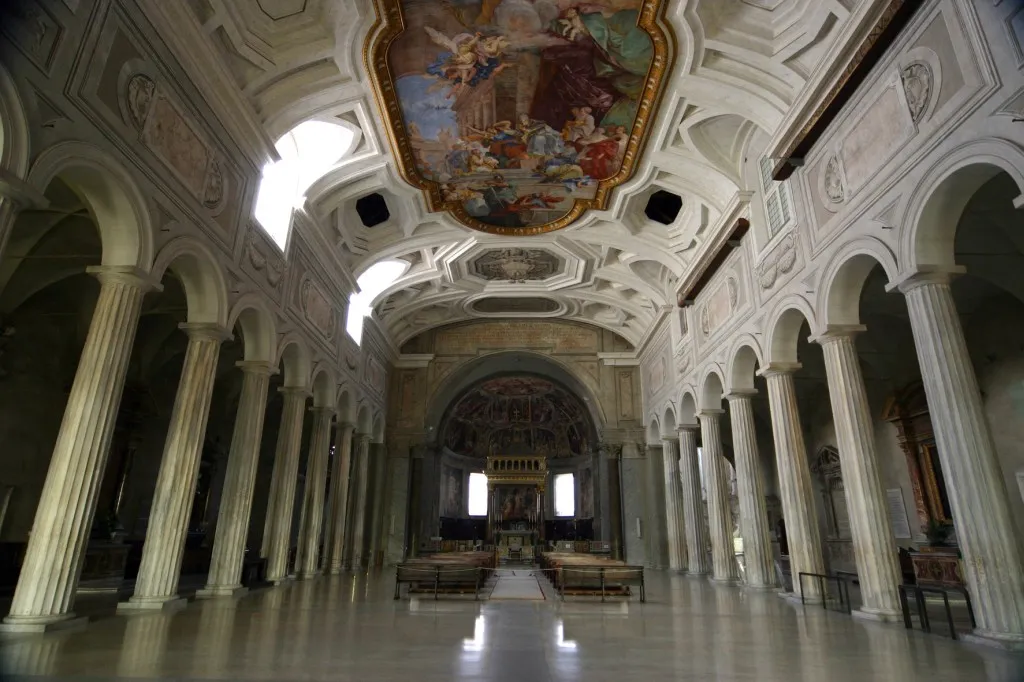
The facade of the basilica overlooks Piazza di San Pietro in Vincoli and is enclosed by the walls of the convent. The apse and external walls are from the original 5th-century structure, while the facade and portico were added during the 16th-century renovations under Pope Sixtus IV and Pope Julius II. The portico, designed by Baccio Pontelli, features five arches supported by six octagonal columns and is enclosed by a bronze gate. This gate bears the coat of arms of Julius II.
The Central Nave and Vault
Inside the basilica, the central nave is divided from the side aisles by twenty Doric columns made of Hymetius marble, likely sourced from Greece. These columns may have been taken from the nearby Portico of Livia. The columns’ bases were updated in the 5th century to match the period’s style.
The nave’s barrel-vaulted ceiling is adorned with coffers, which were created by Francesco Fontana in 1706. The fresco in the center of the vault, by Giovanni Battista Parodi, depicts a legendary event from 969, in which a count in the retinue of Emperor Otto I is freed from the devil by touching St. Peter’s chains. The floor, which was removed in 1956 for archaeological excavations, was later replaced with new construction.
Side Aisles and Chapels
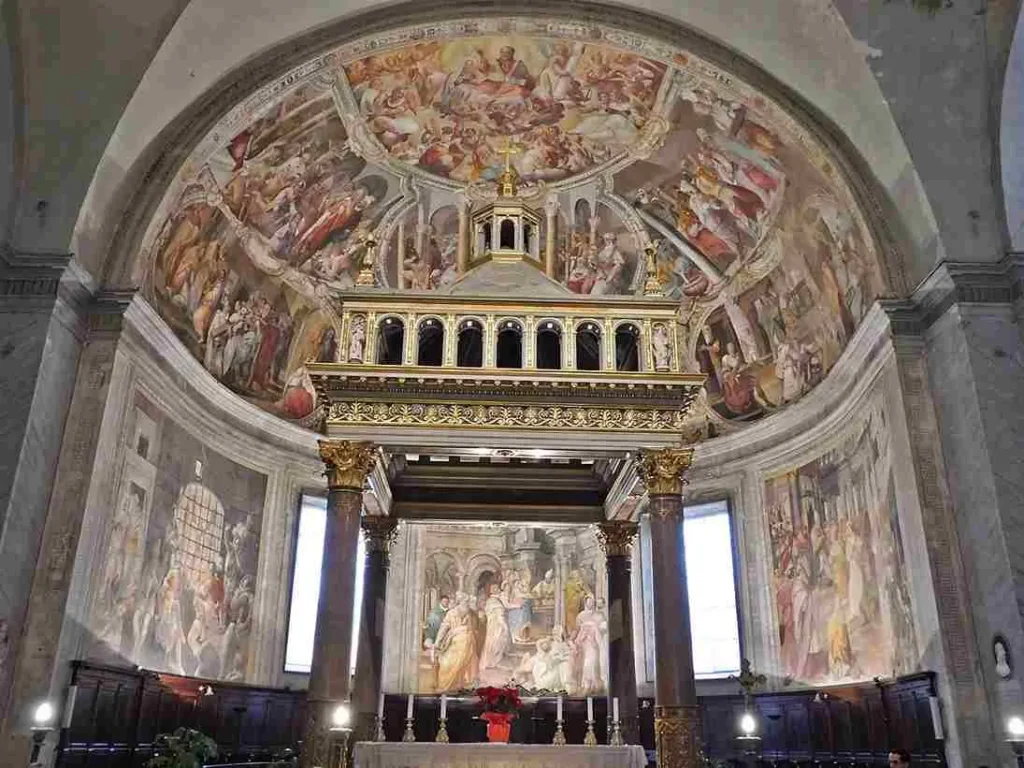
- The Tomb of Nicholas of Cusa is located near the beginning of the left nave. It features a sculpture by Andrea Bregno of the cardinal venerating Saint Peter, with an angel on the right.
- The first altar on the left nave holds a Deposition of Christ by Cristoforo Roncalli (Pomarancio).
- The third altar on the left nave features a mosaic of Saint Sebastian, a unique depiction of the saint as an older, bearded figure, shown in Roman attire but in Byzantine-style robes. It was moved to its current position in 1683.
- The first altar on the right nave contains a painting of Saint Augustine by Guercino, painted between 1621 and 1623.
- The Liberation of St. Peter by Domenichino is displayed in the sacristy. A copy of this work was placed in the third altar of the right nave in 1683.
The Presbytery, Apses, and Reliquary of Chains
The presbytery and apses were redesigned between 1876 and 1877, with the central altar remaining from Cardinal Cusano’s 1465 renovations. The altar features a reliquary that houses St. Peter’s chains. These chains are divided into two pieces: one from St. Peter’s imprisonment in Rome and another from Jerusalem. The reliquary, crafted in 1856 by Andrea Busiri Vici, is flanked by statues of Saint Peter and the Liberating Angel. A bronze door by Giovanni Matteo Foppa, dating back to 1477, encloses the relics. The crypt, below the central altar, is thought to have been the first prison of St. Peter in Rome. It houses the sarcophagus of the Seven Maccabean Brothers, along with a fresco of their martyrdom painted by Silverio Capparoni in the late 19th century.
The Tomb of Pope Julius II and Michelangelo’s Moses
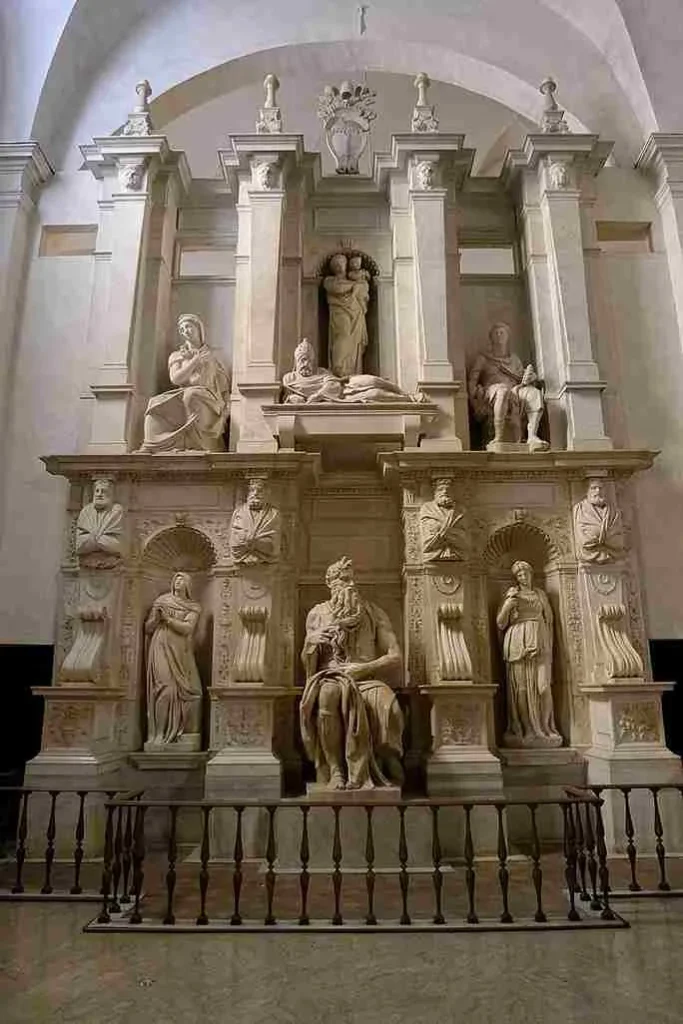
The Tomb of Pope Julius II is located in the right transept. The original design, commissioned in 1505, included more than forty statues, but due to multiple interruptions, the final monument was much smaller. Michelangelo’s Moses became the centerpiece, standing at 2.35 meters tall. The statue, initially facing forward, was repositioned later by Michelangelo to achieve a slight twist, drawing attention away from the chains of St. Peter. The Moses statue is one of the finest examples of Renaissance sculpture. Above the Moses statue is a sarcophagus that was intended to hold the remains of Julius II, with a statue of the Pope lying on his side. Several other statues are included in the tomb, such as Rachel and Leah, symbolizing the contemplative and active life, respectively.
The Pipe Organ
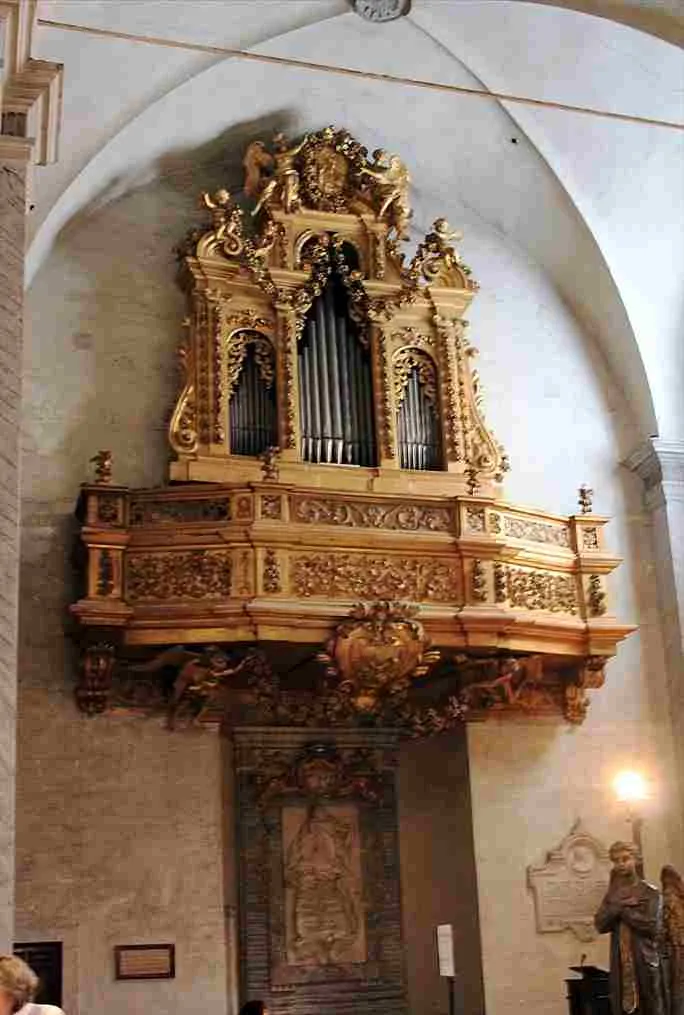
The basilica’s pipe organ is located in the left arm of the transept, in a gallery above. Built in 1686 by Giacomo Alari, it was expanded in 1884 by Attilio Priori and restored between 2012 and 2014 by Michel Formentelli. The organ is housed in a gilded wooden case with 22 registers, and its sound is produced through a mechanical transmission system.
The Sacristy
The sacristy is situated behind the tomb of Pope Julius II and was transformed during the 15th-16th centuries to house St. Peter’s chains. The space is decorated with an oval vaulted ceiling and paintings of St. Peter’s life by Ottavio Mazzienti. The sacristy also holds the famous St. John the Baptist painting, once stolen, allegedly bearing a fly drawn by Giotto.
Burials and Gravestones in the Basilica of San Pietro in Vincoli
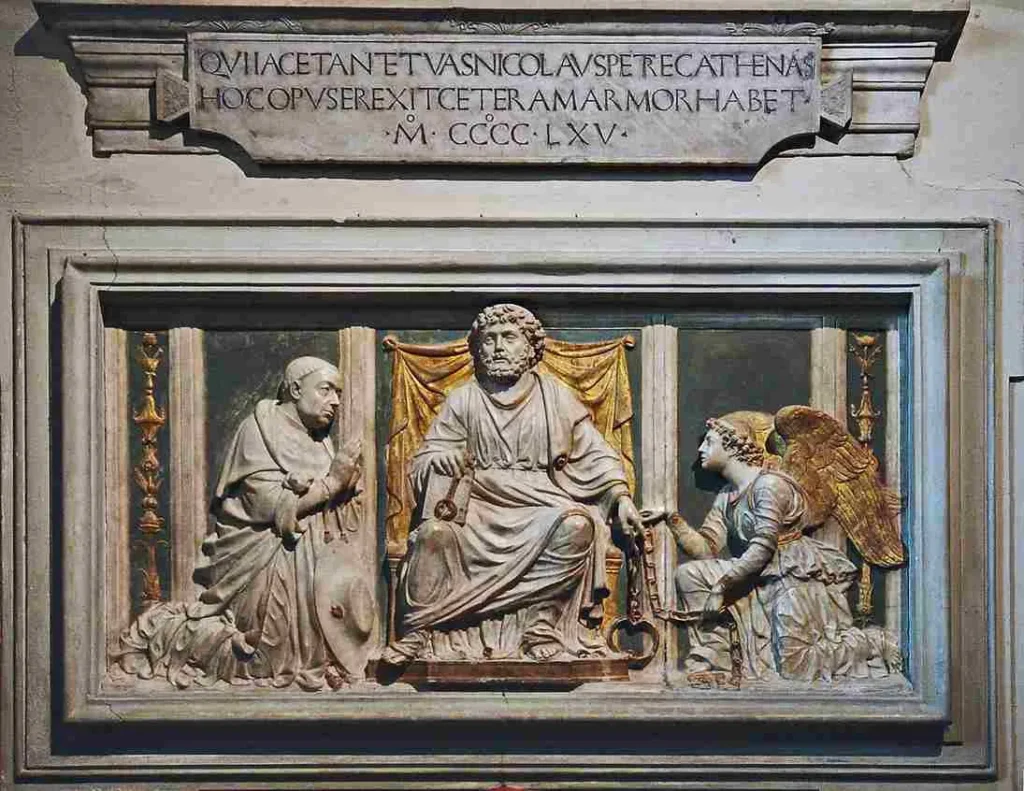
Burials of Cardinals and Bishops
The Basilica of San Pietro in Vincoli houses numerous significant funerary monuments dedicated to cardinals and bishops, many of which are adorned with exquisite sculptures and paintings. Among the most notable tombs are those of Cardinal Cinzio Passeri Aldobrandini, who served as Titular of the basilica from 1605 to 1610, and Cardinal Mariano Pietro Vecchiarelli, whose tomb, dating from 1639, is located in the fourth altar of the left aisle. In front of this altar, a portion of the original flooring is visible, adding historical context to the site.
In the second altar of the right nave lies the tomb of Cardinal Lanfranco Margotti, Titular from 1610 to 1611. Above the tomb is a tondo by Domenichino, painted in 1611, featuring a portrait of the cardinal. Similarly, Cardinal Girolamo Agucchi, who held the title of Titular from 1604 to 1605, is memorialized with a tomb designed by Domenichino. This tomb features a portrait of Agucchi, painted by Domenichino in 1605.
Cardinal Girolamo Della Rovere, Titular of San Pietro in Vincoli from 1587 to 1592, is buried at the end of the right nave, while Cardinal Antonio Andrea Galli, Titular from 1757 to 1767, has his tomb located in the left arm of the transept beneath the organ. Other notable tombstones include those of Cardinal Castruccio Castracane degli Antelminelli (Titular from 1833 to 1844), Cardinal Sisto Gara della Rovere (Titular from 1507 to 1517), and Bishop Giovanni Andrea Bussi, a collaborator of Cardinal Cusano.
The only tombstone still remaining on the floor of the basilica is that of Eustachio Giovenale Orsini, a Roman nobleman who died in 1483. This tombstone is positioned near the right counter-façade wall. Other memorials, including that of Cardinal Niccolò Maria Lercari (Titular from 1743 to 1757), can be found along the counter-façade walls. The tomb of Antonio Benci, a renowned 15th-century Florentine artist, is located to the left as one enters the church. Additionally, the frescoed tombstone of Cardinal Lorenzo Casoni (Titular from 1715 to 1720) can be found in the left transept.
Memorial Stones
Several commemorative plaques throughout the basilica serve to honor the legacy of past cardinals and figures associated with the church. A notable plaque commemorates the election of Cardinal Hélie de Talleyrand-Périgord, who was Titular of San Pietro in Vincoli from 1331 to 1348. Although the plaque does not bear his name, the reference to his birthplace in Toulouse suggests it honors this French cardinal. Originally placed on the floor, this plaque is now mounted on the left wall of the counter-façade.
Other commemorative plaques include those for Cardinal Adolphe-Louis-Albert Perraud, Titular from 1896 to 1906, and Agostino Steuco, located on the left pillar of the apse. On the opposite pillar stands the tomb of Giulio Clovio, a renowned miniaturist, who passed away in 1578. These memorials, along with the many tombs and gravestones, contribute to the basilica’s rich historical and artistic heritage, ensuring that the memory of these individuals endures.
Feast Day
Feast Day: 1st August
The feast day of the Basilica of St. Peter in Chains (Basilica di San Pietro in Vincoli) in Rome is celebrated on August 1st. This day commemorates the Miracle of the Chains of St. Peter, which marks the miraculous release of St. Peter from imprisonment, and the veneration of the chains associated with this event that are housed in the basilica. The feast is a significant occasion for the basilica, attracting visitors and pilgrims who come to honor St. Peter’s role in early Christianity.
Church Mass Timing
Monday : 8:00 AM , 12:00 PM
Tuesday : 8:00 AM , 12:00 PM
Wednesday : 8:00 AM , 12:00 PM
Thursday : 8:00 AM , 12:00 PM
Friday : 8:00 AM , 12:00 PM
Saturday : 9:00 AM , 11:00 AM
Sunday : 9:00 AM , 11:00 AM
Church Opening Time:
Monday : 8 AM – 12:20 PM, 3 AM – 5:50 PM
Tuesday : 9 AM – 12:00 PM, 3 AM – 5:50 PM
Wednesday : 8 AM – 12:20 PM, 3 AM – 5:50 PM
Thursday : 8 AM – 12:20 PM, 3 AM – 5:50 PM
Friday : 8 AM –12:20 PM, 3 AM – 5:50 PM
Saturday : 8 AM – 12:20 PM, 3 AM – 5:50 PM
Sunday : 9 AM – 12:00PM, 3 AM – 5:50 PM
Contact Info
Address :
Piazza di San Pietro in Vincoli, 4/a, 00184 Rome RM, Italy.
Phone : +390697844952
Accommodations
Connectivities
Airway
Leonardo da Vinci International Airport (FCO), to Basilica of St. Peter in Chains, Rome, Italy distance between 35 min (28.1 km) via A91.
Railway
Roma Termini Via Giovanni Giolitti, Rome, to Basilica of St. Peter in Chains, Rome, Italy distance between 8 min (2.2 km) via P.za Vittorio Emanuele II.

